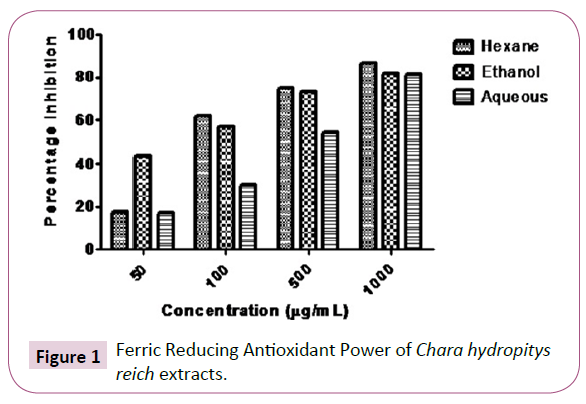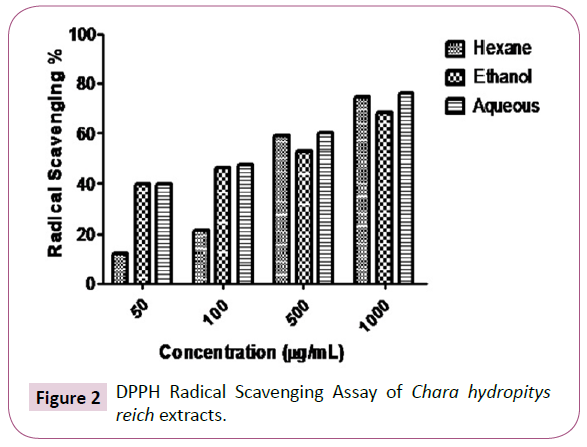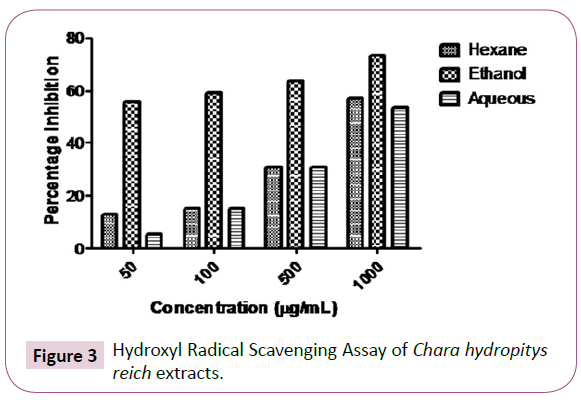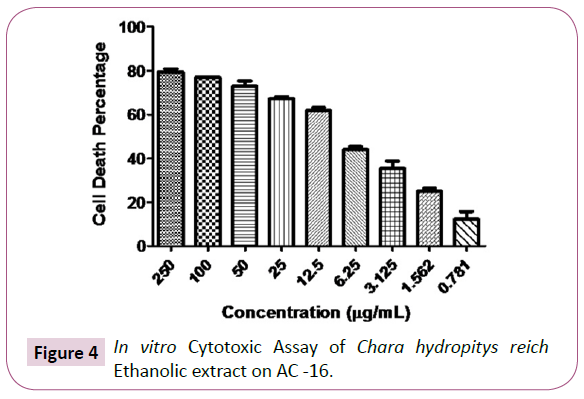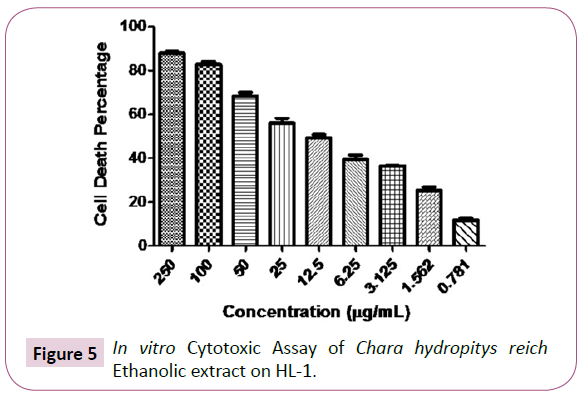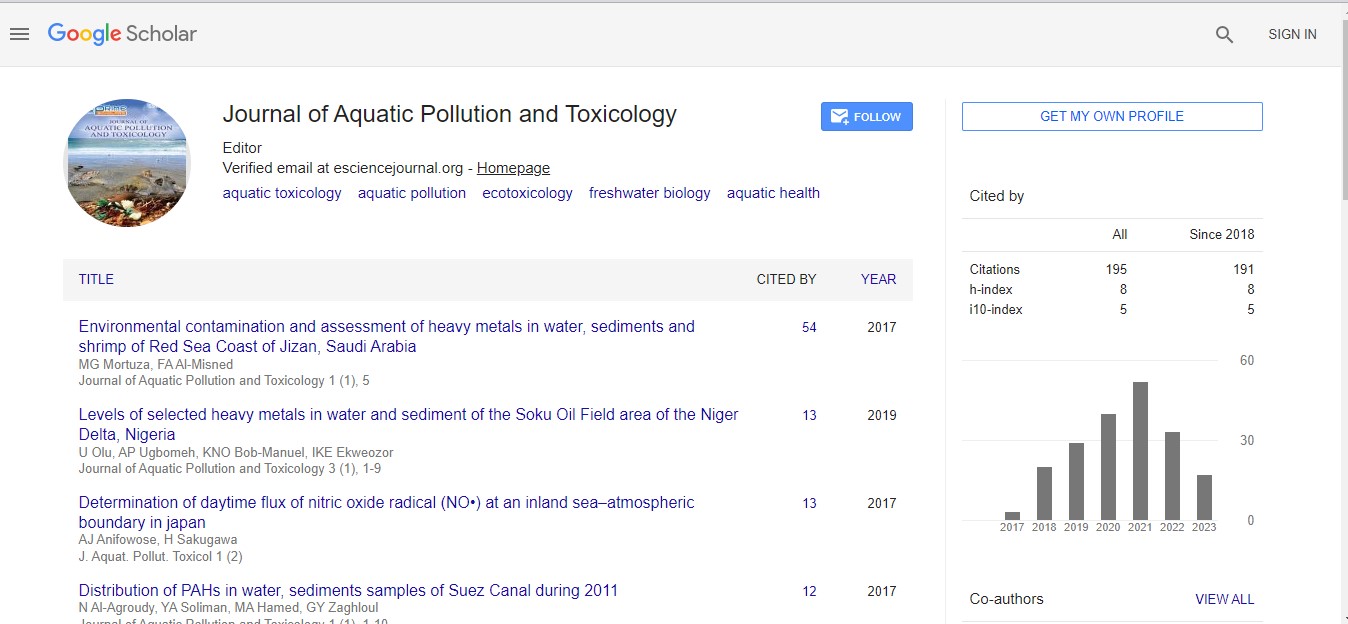Keywords
Chara hydropitys; Phytochemistry; Antimicrobial; Antioxidant; Cardiomyocyte HL-1 Cell Line; Cardiomyocyte AC-16 Cell Line
Introduction
Algae are the diverse group of aquatic organisms that are widely used in industries such as food, pharmaceuticals, cosmeceuticals and nutraceuticals. Among the various types of algae, the macro algae are used in the treatments of various metabolic disorders like cancers, cardiovascular diseases and diabetes. Moreover, certain marine algae are capable of curing viral infections and disorders in the gastrointestinal tract and liver. The bioactive phytochemical compounds of seaweed had received the attention of pharmaceutical companies for drug development.
Freshwater algae contain about 7310 variety of species and the majority of which are blue-green and green algae. These algae occur in the freshwater on submerged surfaces. Chara hydropitys is also a freshwater macro algae belong to the genus Charophtye and family Characeae. It is a multicellular, profusely branched thalloid plant body that typically reaches a height of about 20-30 cm and can be seen in color shades from light gray to green. They grow in less oxygenated areas covered with calcium carbonate and magnesium carbonate deposits. Thus they have gained the name stonewort and other common names include sand grass and musk grass. Chara hydropitys is indigenous to the southern parts of Asia such as Tamil Nadu, Kerala and Sri Lanka. Due to its limited availability, the plant has listed under the IUCN red list of concerned species and minimal research studies have been conducted on this species. Hence an attempt was made in the study to reveal the phytochemical compounds present in Chara hydropitys reich, along with their bioactive and in vitro cytotoxic property [1].
Materials and Methods
Collection and extraction
The algae Chara hydropitys reich was collected from Poondi Lake, Tiruvallur district, Tamil Nadu and authenticated. The collected part was then shade dried and grounded using mortar and pistol. This was followed by sequential solvent extraction using Hexane (100 mL), Ethanol (100 mL), and Distilled water (100 mL) with the Soxhlet apparatus. Obtained extracts were dried and stored at 4ºC.
Phytochemical screening
To 50 mg of solvent-free Chara hydropitys extracts obtained from Hexane, Ethanol and Aqueous, the following tests were performed using standard protocols.
• Alkaloids (Mayer’s Test)–A creamy precipitate is obtained when the extract was dissolved with HCl and Mayer’s Reagent (2 drops).
• Phytosterols (Liebermann Bur chard’s Test)–Array of colours can be visualized when the extract is mixed with chloroform, 2 mL of acetic anhydride and Sulphuric acid.
• Phenolics (Ferric Chloride Test)–Dark green colour develops when the extract was mixed with ferric chloride.
• Tannins (Lead Acetate Test)–A white colour precipitation occurs when the extract was dissolved within the water and 10% Lead acetate.
• Flavonoids (Shinoda Test)–Brick red or Magenta colour appears when it is heated after the addition of alcohol followed by magnesium ribbon and HCl.
• Tri-terpenoids (Noller Test)–When the extract is exposed to tin and thionyl chloride, purple colour indicates positive result.
• Quinones–The appearance of red colour on the addition of sulphuric acid to the extract indicates its presence.
• Saponins–A froth layer of up to 2 cm is observed when 50mg of extract and 20 mL of distilled water was dissolved and mixed vigorously. This indicates the saponin presence.
Quantitative estimation of flavonoids
The flavonoids present in the Chara hydropitys reich extracts were calculated by using Aluminium Chloride colorimetric assay. To various concentrations of the extract (0.5 mL), Potassium Acetate (0.1 mL) and Aluminium Chloride (0.1 mL) were added along with 1.5 mL of Ethanol. Distilled water was used as blank and also in making up the entire solution to 5 mL. The Absorbance value for all the extract was measured at 415 nm using a UV-visible Jasco V-630 instrument with Quercetin as standard [2].
Antimicrobial study
For all the extracts of Chara hydropitys reich of varied concentrations ranging from (10 to 1000 μg/mL), the antimicrobial activity was conducted using micro-organisms such as E.coli, S.aureus, and Aspergillus niger. The methodology adopted was agar well diffusion assay. The Agar plates were prepared using Mueller Hinton Agar, which was received from Hi-media. The procedure was conducted in duplicates and the average values have been deployed.
Antioxidant activity
Ferric reducing antioxidant power assay (FRAP), The assay depends on the antioxidant capacity of the extracts in the reducing Fe3+ to Fe2+ using 2, 4, 6-tripyridyl-s-triazine.To 60 μl of the sample of varied concentration, 1 mL of the instantly prepared FRAP reagent was heated to 37ºC in a water bath and added. In the case of control, the sample was replaced with water. An absorption value at 593 nm was recorded and percentage inhibition was measured [3].
DPPH assay
The radical scavenging property of the Chara hydropitys reich extracts was assayed using the DPPH technique. To 2 mg of extract of varied concentration, 1 mL of DPPH reagent was added and held for 40 min at room temperature. Then, the absorbance was calculated at 517 nm by using UV-Vis spectrophotometer. The assay was performed in triplicates. The below-mentioned formula was used for scavenging Percentage calculation.
Hydroxyl radical scavenging assay
The reaction mixture comprising of 1mL extract (conc. 2–10 mg/ mol), ascorbic acid, EDTA and phosphate buffer (pH 7.4) was heated at 80°C –90°C using a water bath for 15 min. The reaction was stopped by adding 3 mL NASH reagent and 1.0 mL of 17.5% cold Trichloroacetic acid. The colour intensity of the solution was enhanced by 15 minutes of incubation at room temperature. The inhibition percentage was calculated by measuring the final solution at OD 412 nm using a UV spectrophotometer against the blank and keeping ascorbic acid as the standard [4].
The Cardiac cell lines, HL1 and AC16 were acquired from the National Centre for Cell Sciences, Pune. The cell lines were cultured using Minimum Essential Medium along with FBS, streptomycin (100 U/mL) and penicillin (100 U/mL). It was then incubated in a 5% CO2 incubator using a 96-well titre plate for 48 hours at 370C. Further, the cells were washed off the plates through saline. The resultant was stored in a new medium containing 50 μl of 5mg/mL MTT solution and again left for 4 hours incubation. The percentage of viable cells was then calculated from the given formula by using the absorbance values measured at 570 nm.
Results and Discussion
Yield ratio
The yield percentage value of Chara hydropitys reich for the three different is shown in (Table 1). The highest yield was observed in aqueous extract followed by the Ethanol and the Hexane extract [5].
| Extract |
Yield ratio (%) |
| Hexane |
0.9 |
| Ethanol |
2.3 |
| Aqueous |
4.2 |
Table 1: Yield percentage of Chara hydropitys reich extracts.
Phytochemical screening
The phytochemical compounds present in Chara hydropitys reich are listed. The data obtained were consistent with the reports of previous studies carried out on a similar genus. A higher concentration of flavonoids was observed in Ethanol followed by aqueous extract. Trace amounts of alkaloids and saponins were present in both aqueous and Ethanol extracts respectively. Interestingly the hexane extract of C. hydropitys showed a higher concentration of steroids. The present study coincides with the findings from which indicated the presence of alkaloids, saponins and steroids in ethanol extract of C. hydropitys except for tannins. This variation may be due to either the geographical location or undetectable presence of tannin concentration in the extracts of Chara hydropitys reich.
Quantitative estimation of flavonoids
All the extracts contain Flavonoids as an essential phytoconstituent were quantified and tabulated in (Table 2). Only the Ethanolic extract displayed a higher flavonoid concentration when quantified in vitro using Quercetin as standard. Bremer in his study on Chara and Nitella has shown that these primitive living plants are known to contain significant flavonoids, which correlate with the results of the current study [6].
| Extract |
Concentration [QE equivalence] (mg/mL) |
| Hexane |
0.83 |
| Ethanol |
1.54 |
| Aqueous |
0.13 |
Table 2: Quantification of flavonoids in Chara hydropitys reich extracts.
Antimicrobial assay
The study revealed that none of the extracts possess significant antibacterial and antifungal properties. However, the hexane extract of C. hydropitys showed considerable activity against E.coli and Aspergillus niger. The different solvent extracts of Chloro sarcinopsis sp, belonging to the genus Chara also has exhibited similar antimicrobial property.
Antioxidant activity
FRAP estimates the extract’s potential in reducing the Fe3+ to Fe2+ ions against the reactive oxygen species and its reducing potential is directly proportional to the oxidative ability of the substance. In the case of Chara hydropitys reich, the Ethanolic extract exhibited significant antioxidant activity with an IC50 value of 85 μg/mL, followed by Aqueous and Hexane extract. The findings of this study are in accordance with the reports. Where C.hispida’s Ethanolic extract also showed a significant antioxidant property [7].
DPPH scavenging assay
It is based on the scavenging potential of the free radicals which reduces DPPH to DPPH-H, where the absorbance decreases for an increase in extract concentration. The Ethanolic extracts of Chara hydropitys reich demonstrate a significant DPPH radical scavenging behaviour with an IC50 value of 450 μg/mL, 200 μg/ mL and 125 μg/mL for Hexane, Aqueous and Ethanol extracts, respectively. This is because of the oxidative potential of the extract that is capable of suppressing the stable free radicals. In an earlier study carried out on the methanolic extract of Nitella tenuissima belonging to Characeae family was reported to possess radical scavenging and therapeutic property (Figures 1 and 2) [8].
Figure 1: Ferric Reducing Antioxidant Power of Chara hydropitys reich extracts.
Figure 2: DPPH Radical Scavenging Assay of Chara hydropitys reich extracts.
Hydroxyl radical scavenging assay
Hydroxyl radicals are powerful free radicals that communicate with biological molecules in the live cells and triggers tissue damage. The Ethanolic extract of Chara hydropitys displayed a higher value in the assay with an IC50 value of 850 μg/mL by the degradation of deoxyribose in Fe3+ EDTA-ascorbic acid and H202 mixture. The report of has also indicated the presence of flavonoids in significant concentration along with the hydroxyl radical scavenging property. The hydroxyl radical scavenging assay of C. hydropitys of this study also exhibited similar outcomes (Figure 3) [9].
Figure 3: Hydroxyl Radical Scavenging Assay of Chara hydropitys reich extracts.
In vitro cytotoxicity study
The cancer cell death percentage at 100 micrograms concentration ranges between 76% and 83% on AC-16 and HL-1 cell lines respectively. In the absence of Chara hydropitys reich extract, there was no significant reduction in viable cells. However, when the cells were exposed to C. hydropitys extract of 100 μg/mL reduction in cancer cells was observed. From this, it is evident that Chara hydropitys reich shows considerable damage to cancer cells. The IC50 value for Ethanol extract on AC-16 cell was 6.13μg/mL and the IC50 value for Ethanolic extract on HL-1 cell was 12.03 μg/mL. The Chara elegans which was reported to be promising algae to treat cancer as it capable of inhibiting the proliferation of cancer cells. The present study also indicates a similar observation, where the Ethanol extract of C. hydropitys of inducing cytotoxic effect on AC-16 and HL-1 cell lines (Figures 4 and 5) [10-12].
Figure 4: In vitro Cytotoxic Assay of Chara hydropitys reich Ethanolic extract on AC -16.
Figure 5: In vitro Cytotoxic Assay of Chara hydropitys reich Ethanolic extract on HL-1.
Conclusion
Among the extracts of Chara hydropitys reich, the aqueous extract showed the highest yield. However, the Ethanolic extract of Chara hydropitys contains significant flavonoid concentration along with significant antioxidant property and in vitro cytotoxic property. In case of the antimicrobial study, ethanol extract alone showed considerable activity against E. coli and Aspergillus niger only. It is now evident from this study that the Ethanolic extract of Chara hydropitys possesses active compounds responsible for the above bioactivities. Hence further studies on the Ethanolic extract of Chara hydropitys may reveal the active compounds that can be extensively used in the development of therapeutic agents.
References
- Roy S, Anantharaman P (2017) Potential and actual therapeutic and medicinal applications of marine macro algae : A Review. Int J Trend Scientific Res Dev 1: 1190-213.
- Casanova MT (2005) An overview of Chara L. (Characeae, Charophyta) in Australia. Aust Syst Bot 18: 25-39.
- Zhishen J, Mengcheng T, Jianming W (1999) The determination of flavonoid contents in mulberry and their scavenging effects on superoxide radicals. Food Chem 64: 555-559.
- Magalia S, Essayag MS, Capriles CHD (2004) Well diffusion for antifungal susceptibility testing. Int J Infect Dis 8: 39-45.
- Benzie IFF, Strain JJ (2004) Ferric reducing/antioxidant power assay: Direct measure of total antioxidant activity of biological fluids and modified version for simultaneous measurement of total antioxidant power and ascorbic acid concentration. Method Enzymol 299: 15-27.
- Mossman T (1983) Rapid colorimetric assay for cellular growth and survival: application to proliferation and cytotoxicity assays. J Immunol Method 65: 55-63.
- Mukherjee S (1977) Some new records of chromosome numbers in Indian Charophyta. Cytologia 4: 227-32.
- Manikanta GS, Somashekhar GM (2018) Phytochemistry and anti-microbial activity of Chara. J Pharmacog Phytochem 7: 2047-2050.
- Bremer K (1985) Summary of green plant phylogeny and classification. The Willi Hennig Soc 1: 369-385.
- Periasamy M, Pandurangan A, Sekaran S, Jebamalai KS, Babu S, et al. (2010) Antibacterial activity and qualitative phytochemical analysis of selected seaweeds from the Gulf of Mannar region. J Exp Biol 1: 23-26.
- Chen JW, Zhu ZQ, Hu TX, Da-Yuan Zhu, Zhu DY (2002) Structure-activity relationship of natural flavonoids in hydroxyl radical-scavenging effects. Acta Pharmacologica Sinica 23: 667-72.
- Murat K, Ilkay O, Abu-Asaker M, Senol FS, Tahir A, et al. (2009) Antioxidant and anticholinesterase assets and liquid chromatography-mass spectrometry preface of various fresh-water and marine. Phcog Mag 5: 291-297.

